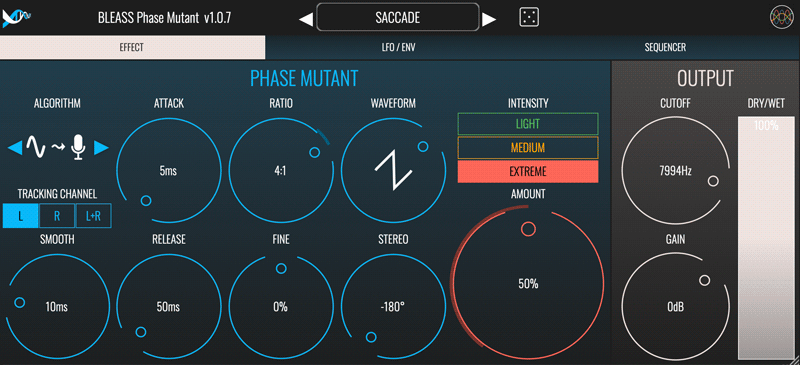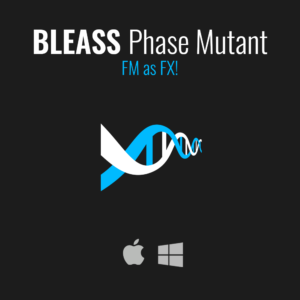Developing BLEASS Omega gave us the perfect opportunity to take a deep dive into the fascinating sonic capabilities of FM synthesis, and this sparked an innovative idea: A plugin that can apply the principles of frequency modulation to literally any source material.
The result is BLEASS Phase Mutant.

Where existing phase distortion plugins create their effect by using an audio input signal to modulate itself, BLEASS Phase Mutant takes things to an entirely new level with the addition of an oscillator that can modulate the input signal or be modulated by it. This allows BLEASS Phase Mutant to fully harness FM’s ability to create complex and colourful harmonic distortions, achingly expressive tonal variations, and fascinating sonic hooks.
BLEASS Phase Mutant’s oscillator tracks the input signal’s pitch, and can be set to a factor of that input pitch. It can also produce a range of different waveforms, all of which can be spread across the stereo field by offsetting the phase of left and right channels.
In combination, these abilities open up a whole new universe of unique, modern-sounding effects that are perfect for vocals, basses, arpeggios and leads. You’re going to love what BLEASS Phase Mutant can do to your drum and percussion parts too!
BLEASS Phase Mutant harnesses the principles of frequency modulation (FM) and applies them to any input signal. The input signal can be modulated by itself, can be modulated by a generated signal, or can modulate a generated signal. Each option opens up swathes of fascinating and complex sonic textures.
BLEASS Phase Mutant offers three Algorithms:
- Oscillator Modulates Input
- Input Modulates Oscillator
- Input Modulates Itself
- Tracking Channel selects the channel that will be analysed by the pitch tracker (Left, Right, or the sum of both channels)
- Smooth sets the time taken for the tracker to move from one pitch to another. Use very fast times for very close pitch tracking; use slightly longer times (10-30ms) to smooth out very short-term pitch variations; use longer times (>100ms) for interesting slurring and portamento-style effects.
- Attack and Release control the attack and release durations of the generated signal.
- Ratio modifies the frequency of the generated signal by applying a multiplier to the detected frequency. The multiplier is shown as a ratio value from 1:8 (three octaves below the detected pitch) to 8:1 (three octaves above the detected pitch).
- Fine allows the oscillator’s frequency to be tweaked by +/- 1 octave.
Further control over the FM processing creates a vast range of different results:
- Intensity determines the maximum modulation amplitude. Note that this can have an impact on the plugin’s latency, and this may be noticeable when the plugin is used on live signals (see “About Plugin Latency” below).
- Amount sets the amplitude, or strength, of the modulation; the maximum amplitude is dependent on the Intensity setting.
- Cutoff controls the cutoff frequency of the low-pass filter that is applied to the processed signal.
- Gain applies a volume change to the processed signal, from -12dB to +6dB.
- Dry/Wet allows you to set the balance between the processed signal and the unprocessed signal passed through from the plugin’s input.
The characteristics of the generated waveform, and the way in which it is applied, have a big impact on the sounds that BLEASS Phase Mutant produces:
-
-
-
- Waveform controls the shape of the generated signal. The shape can be morphed smoothly from sine wave, through triangle and sawtooth waves, to square wave.
- Stereo creates a phase offset between the left and right channels of the generated signal or input signal (depending on the selected algorithm).
-
-
The Envelope is triggered when the plugin detects a new transient in the input signal:
- Gain adjusts the sensitivity of the transient detection.
- Attack and Release times control the shape of the envelope.
- Choose up-to two Target parameters and set the Amount of envelope signal that is sent to those parameters.
BLEASS Phase Mutant includes four modulation sources that can automatically modify the plugin’s parameters. Each modulation source can control any two parameters.
Two Low Frequency Oscillators (LFOs) are included:
-
- The Waveform selector lets you choose from six different LFO waveform patterns.
- Synchronise the LFO to the Beat of your music, or let it run Free at its own rate.
- Rate determines the speed at which the LFO oscillates. Rate uses beat divisions when in Beat sync mode, or milliseconds when in Free sync mode.
- Offset offsets the phase of the LFO in Beat mode.
- Choose up-to two Target parameters and set the Amount of LFO signal that is sent to those parameters.
BLEASS Phase Mutant includes a graphical step Sequencer that allows you to create rhythmic and stepped parameter modulations:
- Length sets the number of steps within the sequence.
- Resolution determines the beat length of each step
- Modulation values are drawn in the sequencer’s Grid. The values and curves you draw in the grid can Snap to the grid’s horizontal guidelines if desired. You can also fully Reset the value of all steps.
- Buttons below each step control how that step works. Steps can output a constant value, or can output a changing value that transits from one value to another. In this way, complex and interesting rhythmic patterns can be created.
- Randomness applies a random offset to the values defined in the sequencer.
- Smooth smoothes-out any sudden changes in step values.
- Choose up-to two Target parameters and set the Amount of sequencer signal that is sent to those parameters.
PLUGIN LATENCY COMPENSATION
The Oscillator Modulates Input and Input Modulates Itself algorithms need to “look ahead” at the incoming signal, and this introduces a small amount of latency/plugin processing delay. Your DAW manages this for you when playing back recorded parts, but it cannot do this on live inputs. This can result in a noticeable delay when processing live signals – the longer the latency, the more noticeable it will be.
The latency introduced by BLEASS Phase Mutant depends on the Intensity setting, as follows:
-
- Light introduces 1ms of latency.
- Medium introduces 10ms latency.
- Extreme introduces 50ms latency.









